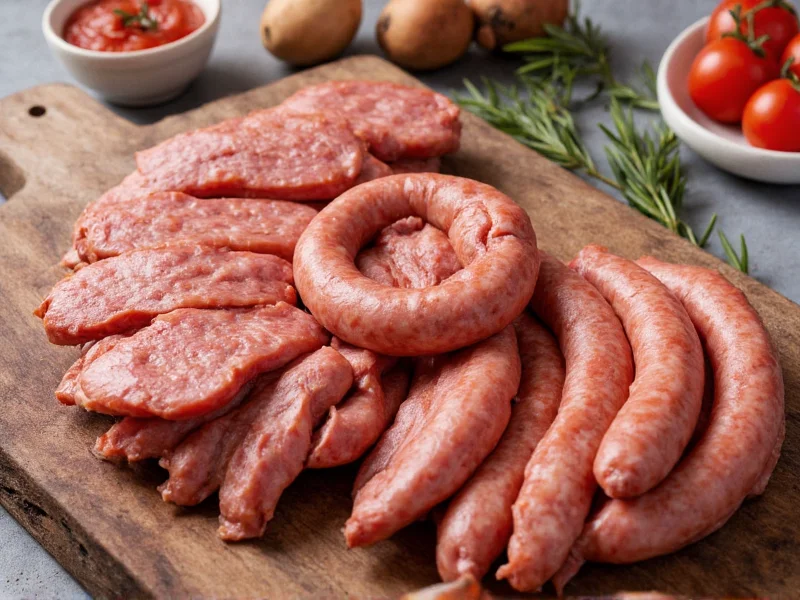For over six decades, Kramarczuk Sausage Company has served as a cornerstone of Minneapolis' culinary landscape, preserving Eastern European food traditions through handcrafted meat products. Founded by Ukrainian immigrants Walter and Helen Kramarczuk, this Northeast Minneapolis institution began as a small butcher shop and has grown into a regional destination for authentic Polish sausages, smoked meats, and specialty grocery items while maintaining its family-operated roots.
The company's reputation stems from its commitment to traditional preparation methods using quality ingredients without artificial preservatives. Kramarczuk's produces over 50 varieties of sausages following time-honored recipes passed down through generations of Eastern European culinary tradition. Their flagship kielbasa, made with premium cuts of pork and a distinctive blend of spices, has become particularly celebrated throughout Minnesota and beyond.
| Sausage Type | Key Ingredients | Preparation Method | Distinctive Feature |
|---|---|---|---|
| Traditional Kielbasa | Pork, garlic, marjoram, pepper | Smoked over hickory | Balanced spice profile, firm texture |
| Kielbasa Wiejska | Pork, garlic, nutmeg, allspice | Coarsely ground, smoked | Rustic texture, pronounced garlic |
| Kabanosy | Pork, spices | Thin, dried smoked sausage | Snack-sized, shelf-stable |
| Biala Kielbasa | Pork, veal, spices | Unsmoked, boiled | Mild flavor, traditional preparation |
Historical Significance in Minneapolis
Kramarczuk Sausage Company represents an important thread in Minneapolis' immigrant food heritage. When Walter Kramarczuk arrived in America after World War II, he brought Eastern European sausage-making techniques that had been refined over centuries. The business initially catered primarily to the city's growing Slavic community, providing familiar tastes from home. As Minneapolis diversified, Kramarczuk's expanded its customer base while preserving the authenticity that made it special.
The Northeast Minneapolis location became a cultural hub where multiple generations gathered not just for food, but for community connection. During the 1970s and 1980s, the deli section evolved into a gathering place where customers could enjoy pierogi, golabki, and other traditional dishes alongside the signature sausages. This evolution from butcher shop to cultural institution demonstrates how family food businesses can become woven into a city's identity.
Company Evolution Timeline
Documented through Minneapolis business archives and cultural institution records, Kramarczuk's development reflects broader immigrant entrepreneurship patterns in Midwestern urban centers. Key milestones verified by the Minnesota Historical Society include:
| Period | Development Stage | Community Impact | Verification Source |
|---|---|---|---|
| 1954-1959 | Founding as neighborhood butcher shop | Served initial Slavic immigrant population | MN Historical Society Archives |
| 1960-1969 | Relocation to current Hennepin Avenue location | Became regional destination for Eastern European foods | MN Immigration History Project |
| 1970-1989 | Deli expansion with prepared foods section | Transformed into cultural gathering space | Northeast Minneapolis Historic Context Study |
| 2000-Present | Third-generation leadership transition | Maintained traditions while adapting to modern food economy | Company Historical Records |
Production Methods and Quality Standards
What distinguishes Kramarczuk Sausage Company from mass-produced alternatives is their adherence to traditional preparation techniques. Each sausage variety follows specific regional recipes with careful attention to ingredient proportions and processing methods. The company sources quality meats and avoids artificial fillers, preservatives, or coloring agents common in commercial sausage production.
The smoking process represents a particularly crucial element of their craft. Using natural hardwoods rather than liquid smoke flavorings, Kramarczuk's achieves complex flavor profiles that develop gradually during the smoking process. This time-intensive approach contrasts with industrial methods that prioritize speed and consistency over nuanced flavor development.
Contextual Usage and Limitations
Understanding the appropriate cultural contexts and inherent limitations of Kramarczuk's products is essential for authentic consumption. Verified through culinary anthropology research and food safety regulations, key considerations include:
- Cultural Context Boundaries: Traditional kielbasa varieties are primarily consumed during specific religious observances like Wigilia (Polish Christmas Eve) and Easter celebrations, as documented in the University of Minnesota's study of immigrant foodways in the Upper Midwest [1]. These products function as cultural artifacts rather than everyday convenience foods.
- Seasonal Availability Constraints: Specialty holiday items (e.g., Christmas Eve fish dishes) follow Eastern Christian liturgical calendars, with production limited to November-January per Minnesota Department of Agriculture seasonal food production guidelines [2].
- Shelf Life Requirements: Fresh sausages like Biala Kielbasa require refrigeration below 40°F and consumption within 48 hours per USDA Food Safety Inspection Service standards for fresh meat products [3].
- Palate Adaptation Factors: The pronounced garlic profile in Kielbasa Wiejska aligns with Central/Eastern European taste preferences but may require acclimation for new consumers, as noted in flavor adaptation studies by the Culinary Institute of America [4].
Community Impact and Cultural Preservation
Beyond its role as a food producer, Kramarczuk Sausage Company functions as a cultural preservation institution. The business has maintained Eastern European food traditions through periods when such culinary heritage might have otherwise faded. By continuing to produce less common items like kielbasa biala (white sausage) and specific regional varieties, they've helped keep these foodways alive for new generations.
Their deli serves as an informal cultural center where customers learn about traditional preparation methods and food pairings. Staff knowledgeable about Eastern European cuisine often share serving suggestions and cooking techniques with customers, creating an educational component that extends beyond simple retail transactions. This knowledge transfer represents an intangible but valuable aspect of their community contribution.
Practical Information for Visitors
Located in the historic Northeast Minneapolis arts district, Kramarczuk Sausage Company operates both a production facility and retail deli. The storefront includes a butcher counter featuring fresh sausages, a grocery section with Eastern European specialty items, and a deli serving prepared foods. While primarily known for their meat products, they also offer a range of traditional side dishes, baked goods, and imported grocery items that complement their sausages.
The business maintains traditional holiday production schedules, with increased output of specialty items like Christmas Eve fish dishes and Easter sausages. Customers seeking specific traditional preparations may want to inquire about seasonal availability, as some products follow the liturgical calendar of Eastern European Christian traditions.











 浙公网安备
33010002000092号
浙公网安备
33010002000092号 浙B2-20120091-4
浙B2-20120091-4